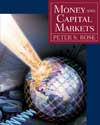 |  Money and Capital Markets: Financial Institutions and Instruments in a Global Marketplace, 8/e Peter Rose,
Texas A & M University
Measuring and Calculating Interest Rates and Financial Asset Prices
Chapter SummaryInterest rates and security prices are among the most important ingredients needed to help
make sound financial decisions. Over the years, a number of methods have been developed
to aid in the measurement and calculation of interest rates and security prices within the financial
system. The intelligent participant in the financial markets today must learn how to
distinguish one interest rate and price measure from another.
- Two of the most widely used and conceptually sound measures of the rate of return on
a security or other financial asset are the yield to maturity and the holding-period yield.
Both take into account the size and timing of all payments expected to be received from
a financial instrument and consider the time value of money (that is, payments to be received
sooner are more valuable, dollar for dollar, than payments to be received later).
- In contrast, other interest-rate or return measures, such as the coupon rate (or annual
rate of return printed on a financial asset’s face and set by contract) or the current yield
(consisting of annual interest payments or dividends divided by the price of a financial
instrument) do not consider the present value of any income or principal payments re-ceived
by the holder of a financial instrument.
- In this chapter, we have highlighted one of the fundamental principles of finance: the
mandatory inverse relationship between the prices of debt securities and interest rates.
Falling bond prices, for example, are associated with rising interest rates in the money
and capital markets.
- Often we observe stock prices falling during a period of rising interest rates as well, although
this need not always be so because stock prices are sensitive to several other factors
besides interest rates (such as the condition of the economy and business profits).
- Banks and other lending institutions often calculate the interest (loan) rates they quote
borrowers according to different interest-rate measures. Examples include the simple interest
rate (where interest owed is adjusted for repayments of the principal of a loan),
and the add-on interest rate (where interest owed is added to the principal of a loan and
the payments made by the borrower are calculated by dividing the sum of principal and
interest by the number of payments called for in a loan agreement). Other loan-rate measures
include the discount method (where interest is deducted at the beginning of a loan)
and the APR (or annual percentage rate) which adjusts interest owed for repayments of
loan principal. The APR is subject to regulation so that lenders calculate it in the same
way and borrowers can more meaningfully compare one loan agreement against another
in order to find the best deal available.
- Interest rates or yields on deposits today are increasingly quoted as the annual percentage
yield or APY. Regulations require that depositors receive APY information when
taking out a new deposit or renewing an existing deposit so that the depositor can make
an informed decision.
- Most banks and other depository institutions pay compound interest on their deposits.
This means that interest is earned on accumulated interest as well as on the principal invested
in a deposit. Increasingly deposits accrue compound interest on a daily or other,
more frequent basis than in the past.
- One of the most complicated interest rate and loan payment methods is the procedure
used to figure loan rates and payment amounts on home mortgage loans. Under most
home mortgage contracts payments made early in the life of such a loan go largely to
pay interest; only after several years are substantial portions of home mortgage payments
directed to help repay the loan principal.
In the next two chapters various factors that significantly impact the interest rate attached
to a loan or security are examined. These factors—inflation, maturity or term of a loan, default
risk, taxation, and other influences—often have a significant impact upon the price of
credit in the money and capital markets. |
|




 2003 McGraw-Hill Higher Education
2003 McGraw-Hill Higher Education